How to Teach Your Dog Paw Easily
- Anja Boecker
- Updated: 2023-12-22
Do you envy other dog owners because their pets can do so many tricks and are always the center of attention? Don't worry, a dog that gives paws will soften any heart, and with this item, your darling will soon be able to do the same.
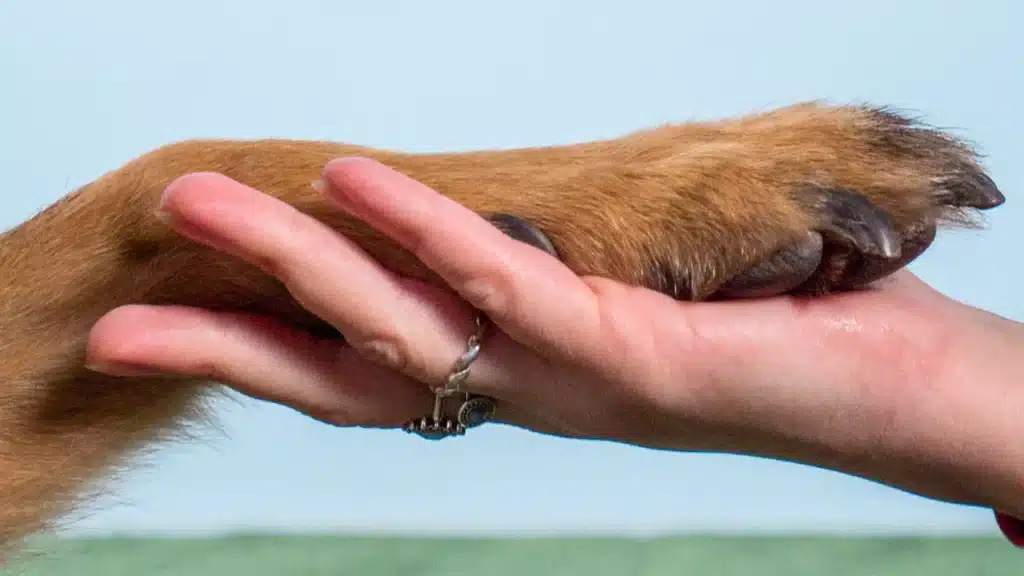
What Is “Pawing” in Dogs?
Use the Paw command to make your faithful companion give you a front paw. This is followed by a reward. "Give Paw" is one of the easier exercises and commands for a dog to learn.
Still, dog owners-and maybe you, too-can reach their limits when it comes to training. But with a few tips and tricks, it's really easy.
We sat down and put together a simple and productive guide for you. We'll also give you some valuable tips on how to help your dog learn.
Why Give Paws?
The "paw" command is one of the most popular tricks that dog owners teach their four-legged friends. But why is this command in particular so popular and what makes it so useful? Let's discover together how and why giving a paw is more than just a fun party trick.
Petting is a wonderful way to strengthen the bond between you and your dog. It builds trust and creates a positive foundation for communication. Learning this trick will challenge your dog mentally and keep his brain active and engaged.
Petting can be the first step to other useful behaviors, such as paw inspection, which makes grooming easier. Petting is a fun activity that makes learning a positive experience for the dog.
In the following sections, we'll show you how to easily and effectively teach your dog to give you paw. Whether you're just starting out or looking for new tips to improve your technique, there's something here for everyone. Are you ready? Then let's get started and have some fun!
Prepare for Training
Before you begin training your dog to heel, good preparation is very important. Laying the proper foundation will make the learning process more enjoyable and effective for both of you. Here are some important things to consider.
Choosing the Right Rewards
Find out what your dog likes to eat best. High-quality, tasty treats increase your dog's motivation and attention. Vary rewards to keep your dog interested. In addition to treats, rewards can include toys or verbal praise.
Choosing a Training Location
Choose a quiet place with no distractions. A familiar setting such as a living room or a quiet garden is a good choice. Make sure you both have enough space to practice comfortably.
Create the Right Atmosphere
Your dog learns best when he is relaxed and alert. Avoid training him when he is tired or overly excited. Your attitude is contagious. Be patient, friendly, and positive to create a comfortable learning environment.
Prepare for Training
Plan short but frequent workouts. Several times a day for 5–10 minutes is often more effective than long, strenuous sessions. Be consistent with your commands and rewards. This will help your dog learn quickly and understand what is expected.
These preparations lay the foundation for successful and enjoyable training. Good preparation is the key to teaching your dog new skills in a fun and effective way.
8-Step Guide
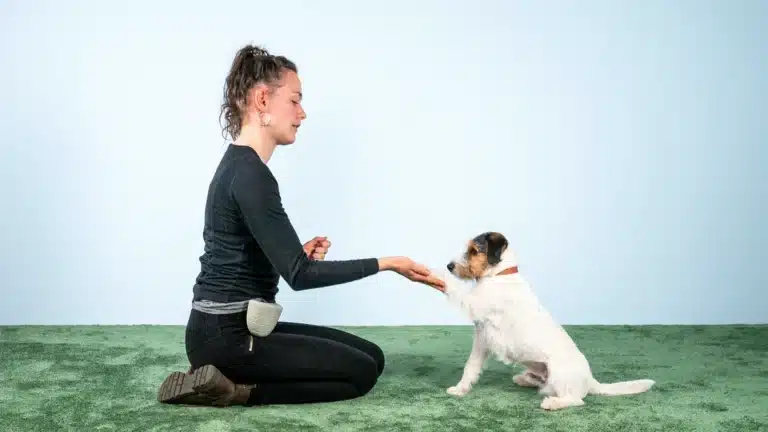
Step #1: The Sitting Position
Ideally, your dog should already know the "Sit" command in order to be able to perform the "Give Paw" command. This command is based on that. Is your furry friend sitting down? Then you can move on to the second step.
Step #2: Focus
Start in a quiet environment and sit on the floor at eye level with your dog. Keep your dog's favorite treats within reach but out of sight to minimize distractions. Make sure your dog is focused on you. You can call his name or show him a treat to get his attention.
Step #3 The Miracle Treat
Hide a treat in your hand in front of your dog and hold your closed hand in front of his nose. Most dogs will try to reach the treat by touching your hand with their snout or paw. Wait patiently until your dog lifts his paw to reach the treat. As soon as your dog tries to reach the treat with his paw, open your hand and give him the treat.
Step #4: Touch Hand
Repeat the previous step, but only release the food when your dog's paw touches your arm or hand.
Step #5: No Treat in Closed Hand
Repeat the previous step, but this time do not hold the treat in your closed hand. Release the treat again when your dog touches your arm or hand with his paw. This time, reward him with a treat from your other hand.
Step #6: Flat Hand
Now offer your dog the palm of your hand. Let him give you his paw and wait a second or two before rewarding him with your other hand.
Step #7: Give the Audible Signal
Now give him a command of your choice while holding out the flat of your hand (e.g., "paw"). Now let the paw rest on your hand for a while. Afterwards, give him plenty of praise and rewards.
Step #8: Practice, Practice, Practice...
Once your dog reliably obeys the command, train him in different environments and situations to reinforce the response. Gradually reduce the frequency of rewards so that your dog isn't just "pawing" for treats.
Remember:
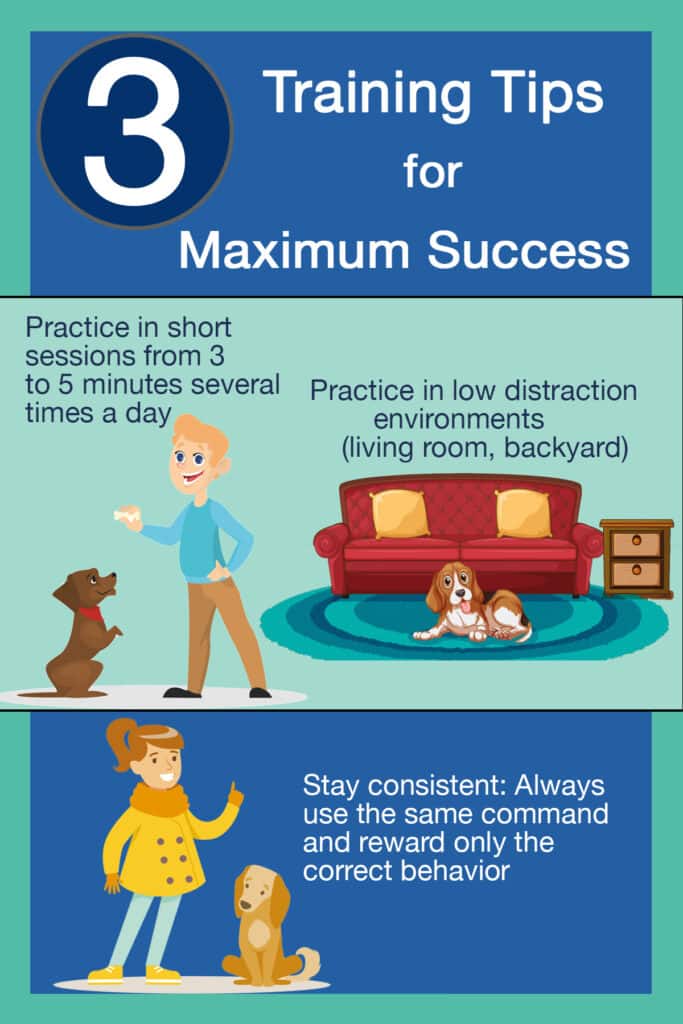
Why Positive Reinforcement?
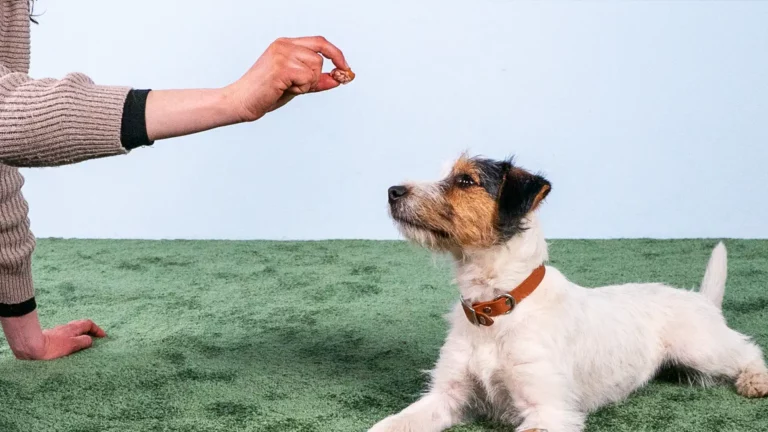
Positive reinforcement is an effective method of dog training. It is based on rewarding desired behavior to encourage it. It plays a crucial role in teaching the "sit" command.
Positive reinforcement makes learning more enjoyable and motivating for your dog. He is more likely to repeat the behavior if he knows a reward will follow. This method is based on trust and understanding rather than fear or intimidation, strengthening the bond between you and your dog.
How Do You Use Positive Reinforcement Effectively?
- Immediate reward: Give the reward immediately after the desired behavior so that your dog associates the action with the reward.
- Clear signals: Use clear commands and rewards so your dog knows exactly what is expected. Always use the same command.
- Varied rewards: Use a variety of rewards such as treats, petting, toys, or verbal praise to keep motivation high.
- Stay consistent: Be consistent in your commands and rewards to avoid confusion and speed learning.
- Reduce the rewards slowly: Once your dog has mastered the command, slowly reduce the reward so that your dog is not working solely for the reward.
Tips for Effective Rewards
- Pay attention to the timing: Reward immediately to reinforce the link between behavior and reward.
- Quality of the reward: Use high-quality rewards that the dog loves to ensure strong motivation.
- Variety in training: Change the type of reward to keep your dog interested.
- Praise and attention: Remember that praise and attention are also powerful rewards.
Common Challenges & Solutions
Teaching the "paw" command can sometimes be tricky. But don't worry, there are solutions to most problems. Here we discuss the most common challenges in teaching the "sit" command and offer practical tips for overcoming them.
1. Dog Shows No Interest
- Problem: Your dog seems to have no interest in giving his paw or responding to training.
- Solution: Try to make the training more interesting by using high quality treats or his favorite toys as rewards. Keep training sessions short and entertaining to keep the dog's attention.
2. Your Dog Immediately Pulls His Paw Back
- Problem: Your dog briefly touches your hand with a paw, but immediately pulls it away.
- Solution: Give the reward more quickly when he touches the paw, even if it is only briefly. Over time, you can wait until he holds the paw longer before giving the reward.
3. Your Dog Is Using the Wrong Paw
- Problem: Some dogs instinctively offer the wrong paw.
- Solution: Focus on rewarding the right paw. You can try gently touching or lifting the right paw to show him which paw you want.
4. Your Dog Gets Too Excited
- Problem: Your dog gets too excited and jumps or barks instead of calmly giving his paw.
- Solution: Keep the training calm and work on impulse control. Give the command in a calm, gentle voice and reward him only when he remains calm.
5. your dog quickly loses interest
- Problem: Your dog quickly loses interest in training or is easily distracted.
- Solution: Keep your training sessions short and gentle. A few minutes several times a day is more effective than a long training session. Also vary the rewards to maintain interest.
With patience, understanding and appropriate technique, most paw training challenges can be overcome. Every dog is unique, so it's important to respond to their specific needs and behaviors. With consistency and positive reinforcement, you will soon see the fruits of your labor.
Ideas for Advanced Users
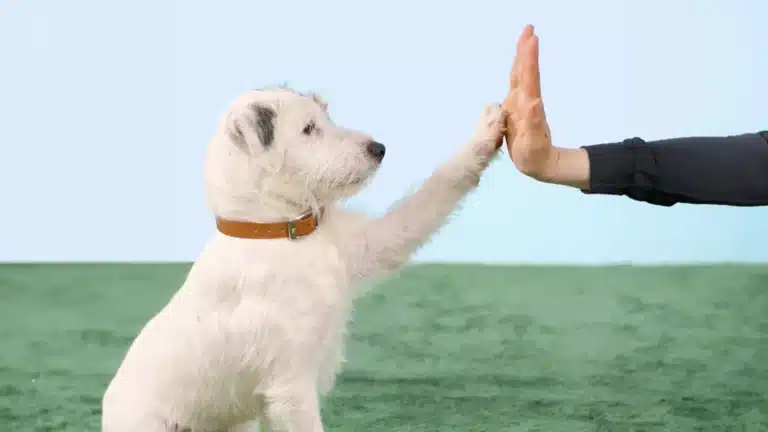
Once your dog has mastered the basic "sit" command, you can expand and vary the training. Here are some ideas on how to take pawing to the next level and keep your dog mentally challenged and entertained.
Alternate Pawing
Teach your dog to alternate between the left and right paws. You can use different commands for each paw, such as "left paw" and "right paw. This combination promotes mental flexibility and the ability to respond to specific commands.
High Five
Expand the "give paw" to a "high five" by holding your hand higher and teaching the dog to clap his paw against your open hand. This provides a fun change of pace and builds coordination.
Paw Cross
Train your dog to cross his paws by lifting one paw and then the other. Paw crossing improves dexterity and body awareness.
Place Paws on Objects
Teach your dog to place his paw on different objects, such as a ball, book, or box. This promotes cognitive flexibility and the ability to follow directions in different situations.
Turns With Paws
Combine giving a paw with a turn. Have your dog turn as you give the paw. This increases the physical challenge and improves coordination.
These extended pawing variations provide a varied challenge for your dog. Remember to introduce each new variation slowly and always work with positive reinforcement. Have fun experimenting and learning together!
Safety Tips & Advice
A safe and positive training experience is critical to your dog's health and well-being. Here are some important safety tips and advice to keep in mind during paw training and other training activities to avoid overwhelm and ensure a positive experience.
Respect your furry friend's individual needs. Every dog is different. Be aware of your dog's individual limits in terms of stamina, concentration, and physical performance. Watch for signs of fatigue or stress, such as yawning, withdrawal or refusal. If your dog shows signs of fatigue, it's time to take a break.
Don't overwhelm your dog with too complicated tasks. Start with simple exercises and gradually increase the level of difficulty. Keep training sessions short and fun. Several short training sessions are more effective and less tiring than one long session.
Use praise, treats, and play as rewards. Avoid harsh or punitive methods that may affect the dog's well-being. Be patient and understanding. If your dog is having trouble learning something, take the time to help him without showing frustration or anger.
Choose a quiet, safe place to exercise, away from potential hazards such as busy streets or sharp objects. Take regular breaks. Give your dog time to relax and rest between exercises. This will prevent overexertion and make training more enjoyable.
Make sure your dog is healthy and has no hidden problems that could be aggravated by training. Check your dog's paws regularly for signs of injury or sensitivity, especially after new or intense exercise.
Frequently Asked Questions
Make sure your dog is sitting and give him a treat in your closed fist. When he scratches your hand with one paw, you can open your hand and give him the treat. Say "Give paw" as you do this. Read the entire article.
You should always create a relaxed atmosphere and always praise and reward your dog when he does something right. With patience, you can teach your dog many tricks. A clicker can help.
Your dog can learn many words and commands and can tell how you are feeling by your voice and tone. Dogs understand more than you think they do.
My Conclusion
It's not hard to teach your dog this command. Just follow our step-by-step instructions. Soon, your favorite dog will stop licking visitors and friends when he greets them, and start greeting them with his hand - sorry, I mean his paw.
Finally, we have written down a few tips and tricks to make training with your four-legged friend easier:
- Be consistent! - It pays off!
- Repeat the exercises over and over again!
- Never use pressure, aggression or reprimands!
- Be patient and - if necessary - invest too much time rather than too little!
- Rewards are reinforced by petting and cuddling.
Pawing is a fun and rewarding skill to teach your dog. Not only does it strengthen your relationship, but it's also valuable mental stimulation.
Remember that each pet is unique and learns at his or her own pace. Celebrate small successes, be patient with setbacks, and most of all, enjoy the time you spend with your loyal companion. Have fun training!
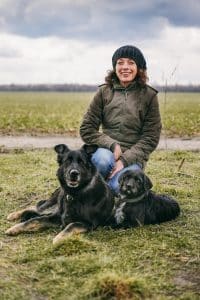
My name is Anja Boecker, and I am a certified dog trainer and behavior consultant. With these articles, I want to help you to understand your dog better and to build an inseparable bond.
Share Now:

